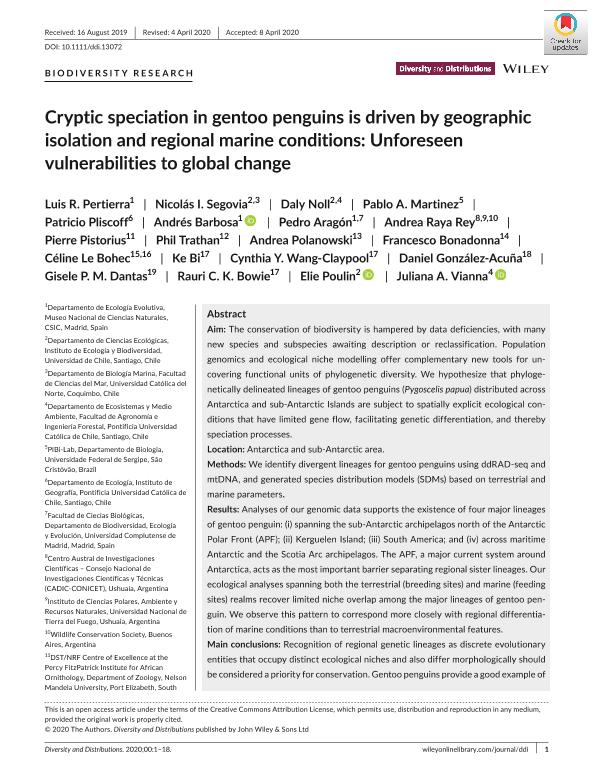Artículo
Cryptic speciation in gentoo penguins is driven by geographic isolation and regional marine conditions: Unforeseen vulnerabilities to global change
Pertierra, Luis R.; Segovia, Nicolás I.; Noll, Daly; Martinez, Pablo A.; Pliscoff, Patricio; Barbosa, Andrés; Aragón, Pedro; Raya Rey, Andrea Nélida ; Pistorius, Pierre; Trathan, Phil; Polanowski, Andrea; Bonadonna, Francesco; Le Bohec, Céline; Bi, Ke; Wang Claypool, Cynthia Y.; González Acuña, Daniel; Dantas, Gisele P. M.; Bowie, Rauri C. K.; Poulin, Elie; Vianna, Juliana A.
; Pistorius, Pierre; Trathan, Phil; Polanowski, Andrea; Bonadonna, Francesco; Le Bohec, Céline; Bi, Ke; Wang Claypool, Cynthia Y.; González Acuña, Daniel; Dantas, Gisele P. M.; Bowie, Rauri C. K.; Poulin, Elie; Vianna, Juliana A.
 ; Pistorius, Pierre; Trathan, Phil; Polanowski, Andrea; Bonadonna, Francesco; Le Bohec, Céline; Bi, Ke; Wang Claypool, Cynthia Y.; González Acuña, Daniel; Dantas, Gisele P. M.; Bowie, Rauri C. K.; Poulin, Elie; Vianna, Juliana A.
; Pistorius, Pierre; Trathan, Phil; Polanowski, Andrea; Bonadonna, Francesco; Le Bohec, Céline; Bi, Ke; Wang Claypool, Cynthia Y.; González Acuña, Daniel; Dantas, Gisele P. M.; Bowie, Rauri C. K.; Poulin, Elie; Vianna, Juliana A.
Fecha de publicación:
05/2020
Editorial:
Wiley Blackwell Publishing, Inc
Revista:
Diversity and Distributions
ISSN:
1366-9516
Idioma:
Inglés
Tipo de recurso:
Artículo publicado
Clasificación temática:
Resumen
Aim: The conservation of biodiversity is hampered by data deficiencies, with many new species and subspecies awaiting description or reclassification. Population genomics and ecological niche modelling offer complementary new tools for uncovering functional units of phylogenetic diversity. We hypothesize that phylogenetically delineated lineages of gentoo penguins (Pygoscelis papua) distributed across Antarctica and sub-Antarctic Islands are subject to spatially explicit ecological conditions that have limited gene flow, facilitating genetic differentiation, and thereby speciation processes. Location: Antarctica and sub-Antarctic area. Methods: We identify divergent lineages for gentoo penguins using ddRAD-seq and mtDNA, and generated species distribution models (SDMs) based on terrestrial and marine parameters. Results: Analyses of our genomic data supports the existence of four major lineages of gentoo penguin: (i) spanning the sub-Antarctic archipelagos north of the Antarctic Polar Front (APF); (ii) Kerguelen Island; (iii) South America; and (iv) across maritime Antarctic and the Scotia Arc archipelagos. The APF, a major current system around Antarctica, acts as the most important barrier separating regional sister lineages. Our ecological analyses spanning both the terrestrial (breeding sites) and marine (feeding sites) realms recover limited niche overlap among the major lineages of gentoo penguin. We observe this pattern to correspond more closely with regional differentiation of marine conditions than to terrestrial macroenvironmental features. Main conclusions: Recognition of regional genetic lineages as discrete evolutionary entities that occupy distinct ecological niches and also differ morphologically should be considered a priority for conservation. Gentoo penguins provide a good example of how conservation policy can be directly impacted by new insights obtained through the integration of larger genomic datasets with novel approaches to ecological modelling. This is particularly pertinent to polar environments that are among the most rapidly changing environments on earth.
Palabras clave:
DIVERSIFICATION
,
ECOLOGICAL NICHE OVERLAP
,
GENTOO PENGUIN
,
SUBSPECIES
Archivos asociados
Licencia
Identificadores
Colecciones
Articulos(CADIC)
Articulos de CENTRO AUSTRAL DE INVESTIGACIONES CIENTIFICAS
Articulos de CENTRO AUSTRAL DE INVESTIGACIONES CIENTIFICAS
Citación
Pertierra, Luis R.; Segovia, Nicolás I.; Noll, Daly; Martinez, Pablo A.; Pliscoff, Patricio; et al.; Cryptic speciation in gentoo penguins is driven by geographic isolation and regional marine conditions: Unforeseen vulnerabilities to global change; Wiley Blackwell Publishing, Inc; Diversity and Distributions; 26; 8; 5-2020; 958-975
Compartir
Altmétricas



